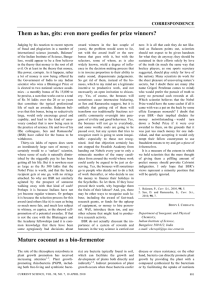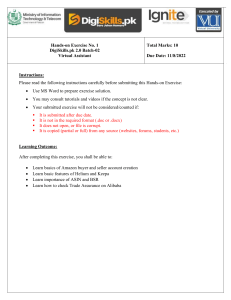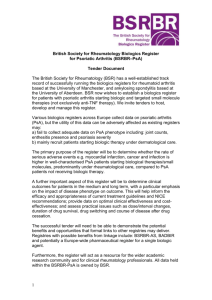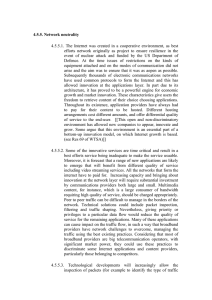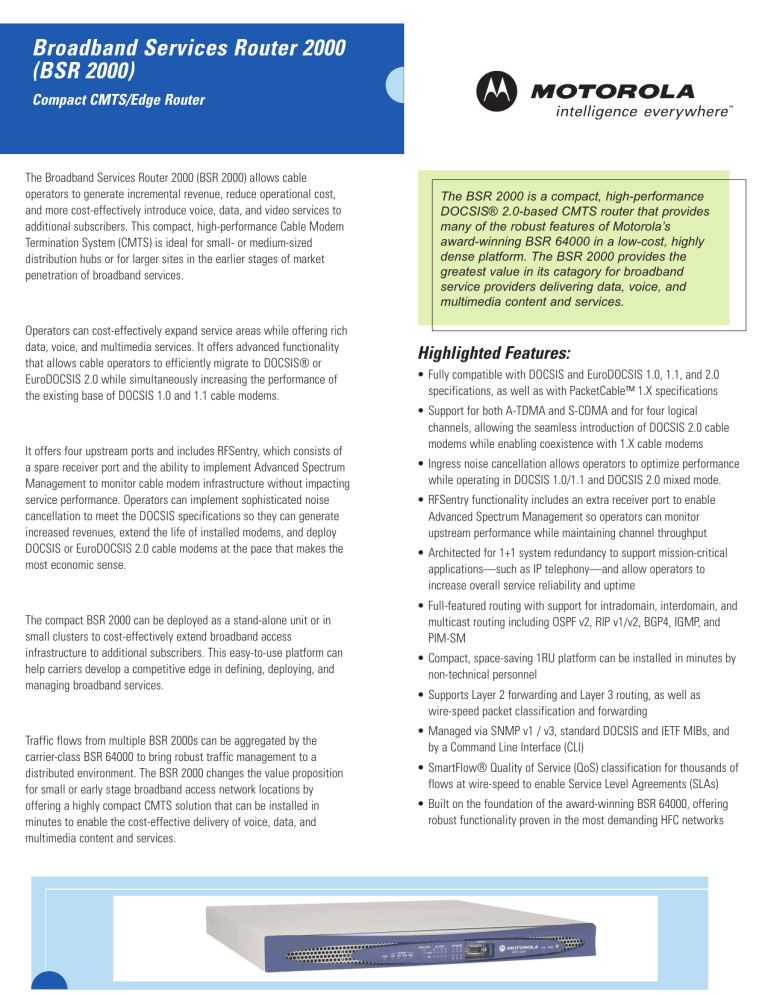
Broadband Services Router 2000 (BSR 2000) Compact CMTS/Edge Router The Broadband Services Router 2000 (BSR 2000) allows cable operators to generate incremental revenue, reduce operational cost, and more cost-effectively introduce voice, data, and video services to additional subscribers. This compact, high-performance Cable Modem Termination System (CMTS) is ideal for small- or medium-sized distribution hubs or for larger sites in the earlier stages of market penetration of broadband services. Operators can cost-effectively expand service areas while offering rich data, voice, and multimedia services. It offers advanced functionality that allows cable operators to efficiently migrate to DOCSIS® or EuroDOCSIS 2.0 while simultaneously increasing the performance of the existing base of DOCSIS 1.0 and 1.1 cable modems. It offers four upstream ports and includes RFSentry, which consists of a spare receiver port and the ability to implement Advanced Spectrum Management to monitor cable modem infrastructure without impacting service performance. Operators can implement sophisticated noise cancellation to meet the DOCSIS specifications so they can generate increased revenues, extend the life of installed modems, and deploy DOCSIS or EuroDOCSIS 2.0 cable modems at the pace that makes the most economic sense. The compact BSR 2000 can be deployed as a stand-alone unit or in small clusters to cost-effectively extend broadband access infrastructure to additional subscribers. This easy-to-use platform can help carriers develop a competitive edge in defining, deploying, and managing broadband services. Traffic flows from multiple BSR 2000s can be aggregated by the carrier-class BSR 64000 to bring robust traffic management to a distributed environment. The BSR 2000 changes the value proposition for small or early stage broadband access network locations by offering a highly compact CMTS solution that can be installed in minutes to enable the cost-effective delivery of voice, data, and multimedia content and services. The BSR 2000 is a compact, high-performance DOCSIS® 2.0-based CMTS router that provides many of the robust features of Motorola’s award-winning BSR 64000 in a low-cost, highly dense platform. The BSR 2000 provides the greatest value in its catagory for broadband service providers delivering data, voice, and multimedia content and services. Highlighted Features: • Fully compatible with DOCSIS and EuroDOCSIS 1.0, 1.1, and 2.0 specifications, as well as with PacketCable™ 1.X specifications • Support for both A-TDMA and S-CDMA and for four logical channels, allowing the seamless introduction of DOCSIS 2.0 cable modems while enabling coexistence with 1.X cable modems • Ingress noise cancellation allows operators to optimize performance while operating in DOCSIS 1.0/1.1 and DOCSIS 2.0 mixed mode. • RFSentry functionality includes an extra receiver port to enable Advanced Spectrum Management so operators can monitor upstream performance while maintaining channel throughput • Architected for 1+1 system redundancy to support mission-critical applications—such as IP telephony—and allow operators to increase overall service reliability and uptime • Full-featured routing with support for intradomain, interdomain, and multicast routing including OSPF v2, RIP v1/v2, BGP4, IGMP, and PIM-SM • Compact, space-saving 1RU platform can be installed in minutes by non-technical personnel • Supports Layer 2 forwarding and Layer 3 routing, as well as wire-speed packet classification and forwarding • Managed via SNMP v1 / v3, standard DOCSIS and IETF MIBs, and by a Command Line Interface (CLI) • SmartFlow® Quality of Service (QoS) classification for thousands of flows at wire-speed to enable Service Level Agreements (SLAs) • Built on the foundation of the award-winning BSR 64000, offering robust functionality proven in the most demanding HFC networks BROADBAND SERVICES ROUTER 2000 (BSR 2000) POWERFUL NOISE MEASUREMENT AND AVOIDANCE FEATURES The BSR 2000 provides ingress noise cancellation, post-equalization, sophisticated noise measurement, and noise avoidance capabilities. It offers the processing power and architectural support for adaptive ingress noise cancellation at the receiver. Diverse noise impairments are measured, analyzed, and cancelled out in real time. Post equalization capabilities offer the ability to increase the throughput of DOCSIS 1.0 cable modems by allowing them to operate in 16 QAM mode virtually anywhere that it is possible to operate in QPSK. The BSR 2000 performs per-burst equalization, which enables the receiver to equalize—and thus correct for—the effects of micro-reflections, amplitude distortion, and group delay distortion. If the noise cannot be cancelled out—such as a very large ingress noise or interferer—the BSR 2000 can avoid the noise by changing the modulation mode or moving frequencies by performing intelligent frequency hopping. PARALLEL RECEIVER ENABLES NON-OBTRUSIVE MONITORING The unique RFSentry feature allows operators to improve performance of all DOCSIS modems. While four receivers per-system are available for servicing subscriber traffic, Motorola has uniquely architected an additional parallel receiver into the system to enable operators to monitor performance on any one of the upstream ports without materially impacting the subscriber experience. This receiver is connected in parallel with a selected receiver port so the operator can measure traffic and performance in real time on any given live receiver port. The parallel receiver can access all of the mapping information as well as a full list of cable modems available to whichever receiver port is currently being evaluated. Therefore, while the receiver port being monitored is performing its function at full capacity, the parallel receiver can non-obtrusively gain access to all of the return nodes connected to one of the receiver ports and perform tests on each upstream channel to assess its quality and take the time required to complete detailed, coherent SNR measurements. REDUNDANCY OPTION FOR HIGH-AVAILABILITY SERVICES The BSR 2000 architecture supports 1+1 redundancy to allow operators to offer high system availability by combining two units in a single location. This 1+1 system redundancy scheme offers a cost-effective, highly available solution for deploying mission-critical applications such as IP telephony in low penetration or emerging service areas. FULL-FEATURED ROUTING AT THE EDGE OF THE NETWORK The BSR 2000 offers a complete feature set in a small package, making it one of the most compact and versatile CMTSs in the industry. Operators can deploy the BSR 2000 as a CMTS to support Layer 2 forwarding or Layer 3 routing. A full suite of routing protocols is supported, including carrier-class implementations of advanced routing protocols such as RIP v1 and v2, OSPF and BGP4. The BSR 2000 also supports IEEE 802.1q VLAN Tagging, which allows users to perform traffic separation for services such as Virtual Private Networks (VPNs). It also offers carrier-grade implementations of IP multicast protocols, including PIM-SM. It supports hundreds of Access Control Lists (ACL) while maintaining wire-speed routing capabilities. The platform supports policy-based routing, where routing is partially determined by inspecting additional fields within the packet. For example, in applications where the operator generates wholesale revenue streams by providing multiple service provider access, the BSR 2000 can inspect a source IP address and then route the traffic to the appropriate partner for handling. NETWORK MANAGEMENT AND CONTROL The BSR 2000 offers flexible options for efficient administration, management, and control to streamline deployment and operations costs. Various levels of custom-defined access privileges can be granted to administrators for management and troubleshooting. The BSR 2000 supports SNMP v1 and v3. Motorola supports all appropriate standard MIBs and offers custom MIBs to monitor and control the BSR 2000's value-added features. The BSR 2000 also offers a Cisco®-compatible CLI for ease-of-use and interoperability with legacy infrastructure. The CLI supports full scripting capability, and ASCII-formatted command files can be uploaded, downloaded, and executed. SMARTFLOW QOS AND MULTI-SERVICE SUPPORT Broadband access networks are the foundation for new classes of entertainment and business services, including: •IP telephony •Interactive, multiplayer gaming •On-demand music, audio, and video •Tiered-data services •VPNs •Application hosting Provisioning these services over shared media requires robust QoS control to deliver the fine levels of service granularity required for real-time applications. Traditional solutions lack the wire-speed QoS capabilities, ingress noise cancellation, and spectrum analysis capabilities required to support diverse services The BSR 2000 with SmartFlow allows per-flow policing and traffic shaping at wire-speed to provide unmatched abilities to offer customized QoS levels to enable SLAs. Operators can deliver QoS from the subscriber to a small distribution hub to the core backbone networks of multiple providers of services, applications, and content. SmartFlow allows operators to classify packets into flows based on packet content and provide the appropriate QoS treatment for each flow using DOCSIS for the upstream HFC network, hierarchical per-flow queuing for the downstream HFC network, and DiffServ for the metropolitan and core networks. BROADBAND SERVICES ROUTER 2000 (BSR 2000) FLEXIBLE DEPLOYMENT APPLICATIONS High-Availability Voice This low-cost, high-value compact CMTS/edge router is based on a space-saving 1RU platform and can be deployed for a wide range of operator requirements, including: Service Area Extension The BSR 2000 allows operators to minimize the costs and risks of extending the service area. It can be deployed at small distribution hubs to allow operators to cost-effectively add services to previously unserved locations. As the service becomes more broadly accepted, additional BSR 2000s can be deployed or a carrier-class BSR 64000 can be deployed to the distribution hub, with the BSR 2000 redeployed to extend the service area to an additional location. Feeders to Centralized BSR 64000s Traffic flows from multiple BSR 2000s can be aggregated by a BSR 64000 to bring robust traffic management to a distributed environment. The BSR 2000 changes the value proposition for small broadband access network locations by offering a highly compact CMTS solution that can be installed in minutes to enable the cost-effective delivery of voice, data, and multimedia content and services. Differentiated Services Operators no longer need to deploy a chassis-based system to gain the benefits of full-featured routing at the network edge. The BSR 2000 allows broadband operators to rapidly introduce differentiated services for both corporate and residential subscribers. It offers the robust routing and the flexibility required to support the emerging generation of revenue-generating services, such as Voice-over-IP (VoIP), VPNs, and multimedia services. A B C D F G H I A. Bits Clock B. Ethernet Backbone Port (RJ-45) C. Ethernet Backbone Port (RJ-45) D. Gigabit Ethernet Backbone Port with SFP connectors E. On/off switch F. Dedicated Redundancy Port G. Ethernet Backbone Port (RJ-45) H. Ethernet Backbone Port (RJ-45) The BSR 2000 is PacketCable-based, and supports PacketCable features, including Dynamic Quality of Service (DQoS) for packet telephony QoS, the Common Open Policy Services (COPS) protocol for allowing network devices to communicate with Call Management Servers, and IPsec for secure communications between the distribution hub and various policy servers located at headends, such as CMS platforms. The BSR 2000 allows operators to meet CALEA requirements, and it includes support for prioritization of Enhanced 911 (E911) emergency service. The BSR 2000 supports per-flow queuing and provides the QoS control to support the demanding requirements of real-time voice services. They can optionally be deployed in redundant configurations so that operators can cost-effectively offer real-time, carrier-class voice services with minimal additional network investments. Hospitality and Multiple Dwelling Units Broadband providers can also deploy space-saving BSR 2000s in hospitality locations or Multiple Dwelling Unit (MDU) facilities to extend broadband services. Just deploy a single, space-saving, 1RU BSR 2000 to provide broadband services to reach new subscribers located in an apartment house, condominium complex, or hospitality location. Multi-Tenant Units Operators can similarly deploy the BSR 2000 to support office parks, campus, and other multi-tenant units to offer voice, data, and multimedia services to small-to-medium size businesses. Wireless Integration Support for wireless broadband applications is also included in the platform, for those cable operators who need to extend their reach beyond the HFC plant so they can offer services using DOCSIS over wireless networks. The BSR 2000 has a separate Intermediate Frequency (IF) interface to support easy and cost-effective connection to wireless transmitters and receivers. The BSR 2000 allows them to offer wireless broadband services to customers where the cable plant is non-existent, such as in rural areas. The BSR 2000 can be integrated with wireless equipment to support high-speed data, voice, and streaming video services, enabling the MSO to attract subscribers in remote areas, where it is not otherwise economical to reach, by extending the cable plant. E J K L M N O I. Gigabit Ethernet Backbone Port with SFP Connectors J. IF Port K. Downstream 0 L. Upstream 0 M. Upstream 1 N. Upstream 2 O. Upstream 3 P. Power P SPECIFICATIONS* COMPACT CMTS NETWORK MANAGEMENT & PROVISIONING Form Factor Height Weight Width Depth Power Input Power Consumption Operating Temperature Non-Operating Temperature Operating Humidity Non-Operating Humidity 1RU “Pizza Box” 1.75” (44.4 mm) 20 Lbs (7.5 kg) 19” (48.3 cm) 19.8” (50.3 cm) 85 – 264 VAC, 47 – 63 Hz 150 W 0º C to 40º C (32º F to 104º F) –13º C to 70º C (–40º F to 158º F) 10 – 80% RH (non-condensing) 5 – 95% RH (non-condensing) Air Flow front to back Cisco-compatible CLI SNMP v1 & v3 Standard DOCSIS and IETF MIBs Telnet Secure Shell – SSH v2 RADIUS TACACS+ Multiple levels of account/password authentication DHCP Relay, including options 60 and 82 Multiple community strings In-band and out-of-band management WIRELESS IF SUPPORT STANDARDS-BASED INTEROPERABILITY DOCSIS 1.0- and EuroDOCSIS 1.0-based DOCSIS 1.1- and EuroDOCSIS 1.1-based DOCSIS 2.0- and EuroDOCSIS based (A-TDMA and S-CDMA) PacketCable and EuroPacketCable 1.1-based: DQOS / IPSEC / COPS / CALEA PacketCable Multimedia (in release 2.0) NETWORK INTERFACES Two Gigabit Ethernet (SFP Module) Supported GE SFP Modules: 1000-based SX Multimode 1000-based LX Single Mode 1000-based EX Single Mode 1000-based ZX Single Mode 1000-based TX RJ-45 Single Mode Four 10/100 Ethernet RIP v2 OSPF v2 DOCSIS, EuroDOCSIS and J-DOCSIS supported 4 upstream DOCSIS receivers Downstream DOCSIS transmitter with integrated, managed upconverter for RF output Advanced Spectrum Management to enable reliable and high-quality service delivery Advanced ingress noise cancellation and post-equalization algorithms Unique, dedicated parallel receiver allows upstream spectrum monitoring without affecting channel throughput QPSK, 16 QAM, 32 QAM, 64 QAM, 256 QAM Upstream Per-Channel Bit Rate: 0.32 – 40.96 Mbps Upstream Input Frequency Range: 5 – 42 MHz DOCSIS 5 – 55 MHz DOCSIS / J-DOCSIS 5 – 65 MHz EuroDOCSIS Downstream Modulation: QPSK1, 16 QAM1, 64 QAM, 256 QAM Downstream Output Frequency Range: 88 – 857 MHz (channel center) Output Frequency Step Size: 125 kHz MULTICAST ROUTING SUPPORT PIM-SM IGMP v2 BRIDGING AND ROUTING Layer 2 Forwarding VLAN Tagging Layer 3 Routing Policy-Based Routing (PBR) SmartFlow wire-speed forwarding and flow classification Hundreds of hardware-based ACLs for wire-speed packet classification and forwarding *Specifications are subject to change without notice. 1 For Wireless DOCSIS Operation MGBI Motorola, Inc. Connected Home Solutions 101 Tournament Drive Horsham, PA 19044 USA US: +1.800.523.6678 Outside the US: +1-215-323-1000 www.motorola.com/broadband MOTOROLA and the Stylized M Logo are registered in the U.S. Patent and Trademark Office. DOCSIS is a registered trademark and PacketCable is a trademark of Cable Television Laboratories, Inc. Cisco is a registered trademark of Cisco Systems, Inc. SmartFlow is a registered trademark of RiverDelta Networks, Inc. All other product or service names are the property of their respective owners. © Motorola, Inc. 2005. All rights reserved. 523578-001 5656–05/05–2K 44 MHz FULL RF SPECTRUM SUPPORT Upstream Modulation: INTRADOMAIN / INTERDOMAIN ROUTING RIP v1 BGP4 Output Frequency



